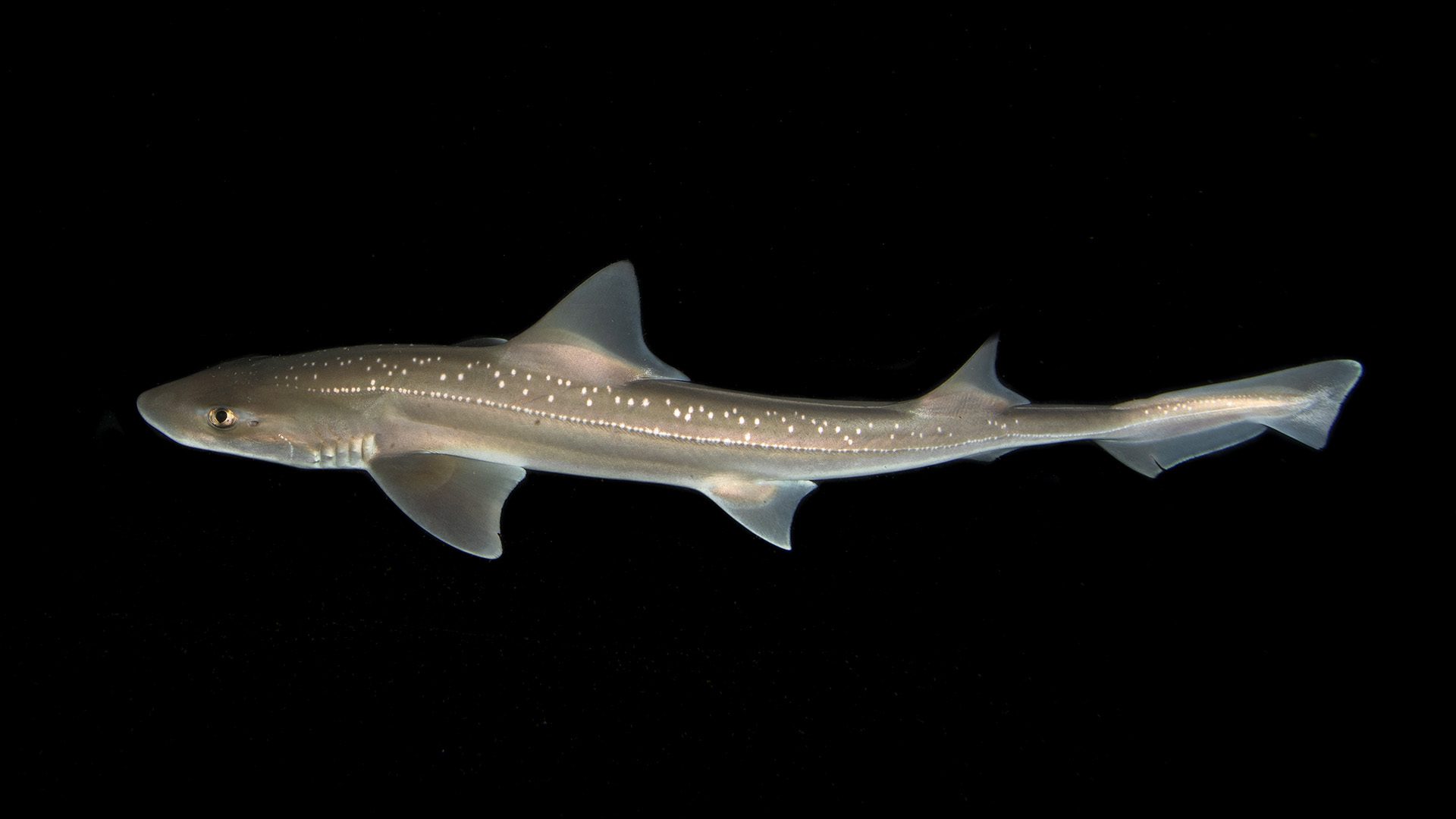
Estimated reading time: 5 minutes
Gnashing teeth, splashy jump scares, and a suspenseful two-note theme were the audible clues with which Steven Spielberg signaled the approach of the otherwise silent great white stalker of his 1975 blockbuster movie hit, Jaws. Now, 50 years later, scientists report for the first time that sharks don’t need a Hollywood director’s help; they are capable of their own unique and mysterious form of sound production.
In the dark expanse of the ocean, the underwater world is acoustically rich. Reef fish chorus in moonlight-driven patterns, highly social marine mammals use sound to cooperate, and snapping shrimps stun prey with rapid claps. However, while sharks can hear and respond to sound, they were previously considered mute. “Look up sharks, and nothing mentions sound production—they have been thought to be ghostly silent,” says Carolin Nieder, a postdoctoral investigator at the Woods Hole Oceanographic Institution (WHOI).
For decades, we’ve understood sharks through a different array of sensory capabilities—an acute sense of smell for detecting a drop of blood over vast distances, the ability to sense the electrical fields of prey, and vision through the ocean’s dim light. But what if we’ve overlooked another, equally important, aspect of their sensory ecology: their ability to detect and produce sound?

WHOI Postdoctoral Investigator Carolin Nieder holds a 3D-printed shark jaw made by staff in DunkWorks Lab within the George & Wendy David Center for Ocean Innovation. (Photo by Daniel Hentz, © Woods Hole Oceanographic Institution)
This question led Nieder to a discovery that may reshape our understanding of how sharks perceive and interact with their environments. Her study, published by The Royal Society of Open Science, revealed something remarkable: when handled underwater, the rig shark isn’t silent at all. Working with researchers at the Université de Liège, and the University of Auckland, Nieder documented what few had suspected
Dr. Aaron Rice, principal ecologist at Cornell University who was not involved in this study, calls it “pretty novel,” noting that while divers reported ray sounds decades ago, shark sounds were overlooked—suggesting they may play a bigger role in communication than previously thought. The finding is particularly surprising given that dogfish sharks have been model species for neurobiology research for decades at institutions like University of Chicago’s Marine Biological Laboratory and WHOI.
Nieder’s finding parallels research from a field study during 2022. Gliding through the waters of Indonesia and Australia, the mangrove whipray and the cowtail stingray began to click when approached by divers. Both ray species belong to the ancient elasmobranch family, a class of cartilaginous fish with distinctive anatomical features. Recently, three other related species, including the blonde ray, the rough skate, and the marbled electric ray, were also reported to produce short, broadband clicks when disturbed by divers, possibly as a threat response. Tracing these evolutionary transitions that go back 450 million years, researchers began to suspect that sharks may be capable of similar sound production.
But studying sharks is not as easy as one might hope. They are elusive in their natural habitats and have rarely been studied up close or while being handled. Nieder was originally conducting research at the University of Auckland on how different types of sharks detect the direction of sound. While handling the rig shark in a tank, she captured underwater vocalizations described as “click… click… click… click.”
Whether rig sharks can acoustically sense their own click sounds, or what function these sounds serve, is not yet understood. Tests of this animal’s hearing range reveal that the clicks produced by rig sharks exceed their low-frequency sensitive hearing range. This raises doubts about whether these sounds play a role in communication between individuals. However, because the initial impulse contains lower frequencies, it's possible that rigs may still be able to hear at least part of them.
Sharks detect sound in two ways: through their inner ears and through the movement of water, which they sense using a row of specialized cells called the lateral line. Dr. Robert Hueter, a senior scientist emeritus at Mote Marine Laboratory, suggests that the initial burst of sound might be strong enough to be felt by nearby dogfish through their lateral line, especially if they are swimming in a group. Dr. Stephen Kajiura, a professor at Florida Atlantic University, believes the high-frequency clicks might be more important as a cue to other species—possibly a predator of the smaller rig shark.
Nieder’s team is analyzing contextual clues to understand the clicks' purpose. While rigs that were handled produced clicks, and produced significantly more during the first 10 seconds of handling than during the subsequent 10 seconds, they were not observed to produce clicks during feeding or while free-swimming in the tank. These findings suggest that initial handling may trigger initial stress and startle the sharks, or the sound could be an anti-predator response in the wild. But as the rigs become habituated to handling, their behavioral response diminishes, resulting in fewer clicks over time.
It's not clear yet how this sound is produced by rig sharks, as elasmobranchs are not known to possess any specialized body part for sound production, and have a flexible, cartilaginous skeleton. The broadband frequency range and short duration of the rig clicks suggest that they may be generated by teeth snapping together.
Given the shared pavement-like teeth among all Mustelus species, it is likely that other members of the genus produce similar sounds. If these sounds come from jaw snapping, other sharks with strong crushing jaws—like Port Jackson sharks—may be able to do the same, Rice suggests. While Nieder’s work has shifted to using acoustic techniques to enhance coral larval settlement in reef restoration efforts, she hopes to return to New Zealand to unravel exactly how these sharks make their sounds—and whether other local shark species might also have voices waiting to be heard. So, while the rig shark is the first of its kind to be recognized for acoustic talents, it’s possible marine biologists may need to make room in their research vessels to study many more. Or, as another Jaws character might put it, “You’re going to need a bigger boat.”



